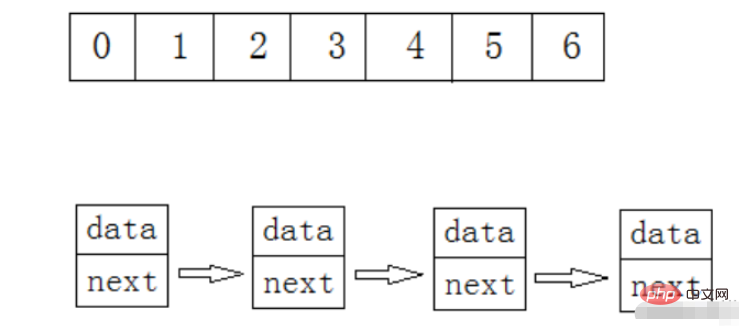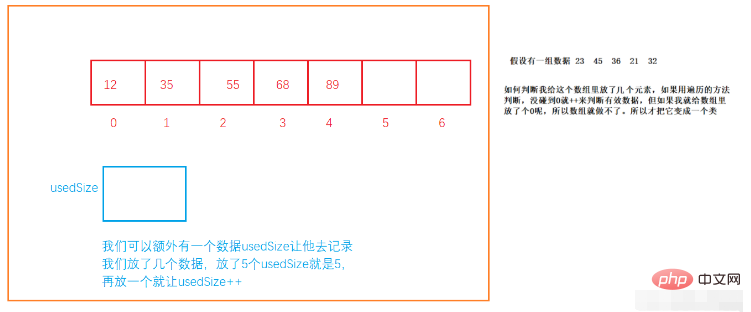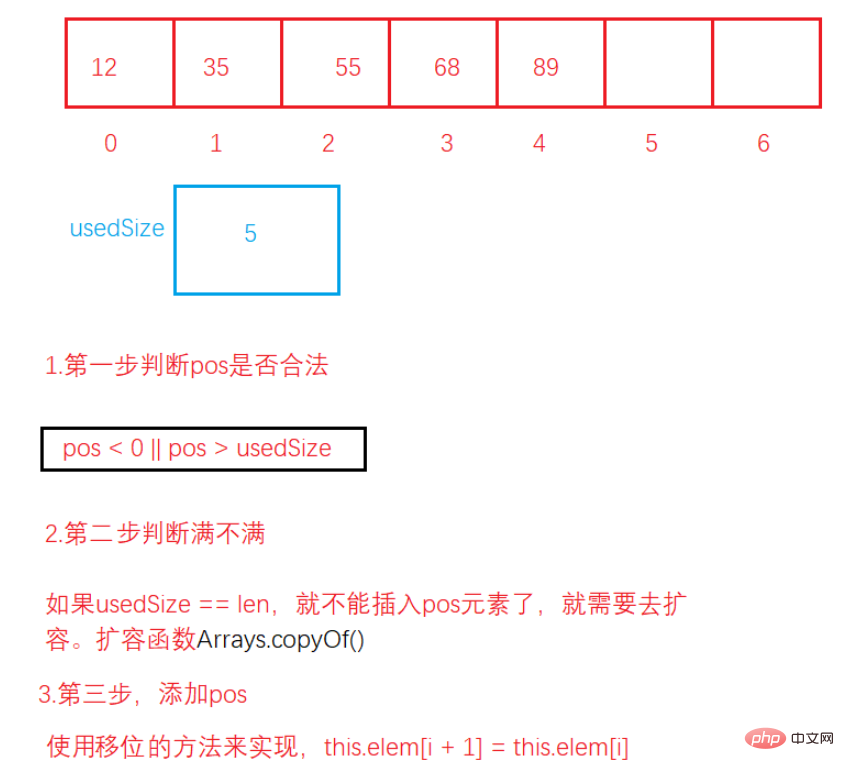How to implement sequential table data structure using Java?
Preface
A linear list is a finite sequence of n data elements with the same characteristics. Linear table is a data structure that is widely used in practice. Common linear tables are: sequence list, linked list, stack, queue, string... Linear table is logically a linear structure, that is to say, it is a continuous straight line. However, the physical structure is not necessarily continuous. When linear tables are physically stored, they are usually stored in the form of arrays and linked structures.

1. Sequence table
1.1 What is a sequence table
A sequence table uses a storage unit with a continuous physical address to store data in sequence The linear structure of elements is generally stored in an array. Complete the addition, deletion, checking and modification of data on the array.
is actually an array. Then why do you need to write a sequence table? Wouldn't it be better to just use an array? The difference is that writing it in a class can be object-oriented.
Sequence tables can generally be divided into:
Static sequence table: Use fixed-length array storage
Dynamic sequence table: Use dynamically opened array storage
Static sequence table is suitable for scenarios where you know how much data needs to be stored.
The fixed-length array of the static sequence table causes N to be too large , it is a waste to open too much space, and it is not enough to open too little.
In contrast, the dynamic sequence table is more flexible, and the space size can be dynamically allocated according to the needs.
2. Simple implementation of the sequence table
2.1 Create sequence table
public class MyArrayList {
public int[] elem;//数组
public int usedSize;//数据的有效个数
public MyArrayList(){
this.elem = new int[10];
}
}
2.2 Print sequence table
//打印顺序表
public void display(){
for (int i = 0; i < this.usedSize; i++) {
System.out.print(this.elem[i] + " ");
}
System.out.println();
}2.3 Get sequence table length
//获取顺序表长度
public int size(){
return this.usedSize;
}2.4 in Add a new element at pos position
When inserting an element into the sequence table, the inserted position must be in front of where the element is stored

//在 pos 位置新填元素
public void add(int pos,int data){
if(pos < 0 || pos >usedSize){
System.out.println("pos 位置不合法!");
return;
}
if(isfull()) {
Arrays.copyOf(this.elem,2*this.elem.length);
}
for (int i = this.usedSize - 1; i >= pos; i--) {
this.elem[i + 1] = this.elem[i];
}
this.elem[pos] = data;
this.usedSize++;
}
//判断是否满
public boolean isfull(){
return this.usedSize == this.elem.length;
}2.5 Determine whether Contains an element
//判断是否包含某个元素
public boolean contains(int toFind){
for (int i = 0; i < this.usedSize; i++) {
if(this.elem[i] == toFind){
return true;
}
}
return false;
}2.6 Find the position corresponding to an element
//查找某个元素的对应位置,找不到返回-1
public int search(int toFind){
for (int i = 0; i < this.usedSize; i++) {
if(this.elem[i] == toFind){
return i;
}
}
return -1;
}2.7 Get the element at pos position
//获取pos位置的值
public int getPos(int pos){
if(pos < 0 || pos >= this.usedSize){
System.out.println("pos 位置不合法");
return -1;//这里说明一下,业务上的处理,不考虑
}
if(isEmpty()){
System.out.println("顺序表为空!");
return -1;
}
return this.elem[pos];
}
public boolean isEmpty(){
return this.usedSize == 0;
}2.8 Set the element at pos position to value
//给pos位置元素更新value
public void setPos(int pos,int value){
if (pos < 0 || pos >= this.usedSize){
System.out.println("pos 位置不合法");
return;
}
if(isEmpty()){
System.out.println("顺序表为空!");
return;
}
this.elem[pos] = value;
}2.9 Delete the elements you want to delete
//删除第一次出现的关键字key
public void remove(int toRmove){
if (isEmpty()){
System.out.println("顺序表为空!");
return;
}
int index = search(toRmove);
if(index == -1){
System.out.println("没有你要删除的数字!");
return;
}
for (int i = index; i < this.usedSize - 1; i++) {
this.elem[i] = this.elem[i+1];
}
this.usedSize--;
//this.elem[useSize] = null;如果数组当中是引用数据类型
}2.10 Clear the sequence list
//清空顺序表
public void clear(){
this.usedSize = 0;
}3. MyArrayList.java
import java.util.Arrays;
public class MyArrayList {
public int[] elem;
public int usedSize;
public MyArrayList(){
this.elem = new int[10];
}
//打印顺序表
public void display(){
for (int i = 0; i < this.usedSize; i++) {
System.out.print(this.elem[i] + " ");
}
System.out.println();
}
//获取顺序表长度
public int size(){
return this.usedSize;
}
//在 pos 位置新填元素
public void add(int pos,int data){
if(pos < 0 || pos >usedSize){
System.out.println("pos 位置不合法!");
return;
}
if(isfull()) {
Arrays.copyOf(this.elem,2*this.elem.length);
}
for (int i = this.usedSize - 1; i >= pos; i--) {
this.elem[i + 1] = this.elem[i];
}
this.elem[pos] = data;
this.usedSize++;
}
//判断是否满
public boolean isfull(){
return this.usedSize == this.elem.length;
}
//判断是否包含某个元素
public boolean contains(int toFind){
for (int i = 0; i < this.usedSize; i++) {
if(this.elem[i] == toFind){
return true;
}
}
return false;
}
//查找某个元素的对应位置,找不到返回-1
public int search(int toFind){
for (int i = 0; i < this.usedSize; i++) {
if(this.elem[i] == toFind){
return i;
}
}
return -1;
}
//获取pos位置的值
public int getPos(int pos){
if(pos < 0 || pos >= this.usedSize){
System.out.println("pos 位置不合法");
return -1;//这里说明一下,业务上的处理,不考虑
}
if(isEmpty()){
System.out.println("顺序表为空!");
return -1;
}
return this.elem[pos];
}
public boolean isEmpty(){
return this.usedSize == 0;
}
//给pos位置元素更新value
public void setPos(int pos,int value){
if (pos < 0 || pos >= this.usedSize){
System.out.println("pos 位置不合法");
return;
}
if(isEmpty()){
System.out.println("顺序表为空!");
return;
}
this.elem[pos] = value;
}
//删除第一次出现的关键字key
public void remove(int toRmove){
if (isEmpty()){
System.out.println("顺序表为空!");
return;
}
int index = search(toRmove);
if(index == -1){
System.out.println("没有你要删除的数字!");
return;
}
for (int i = index; i < this.usedSize - 1; i++) {
this.elem[i] = this.elem[i+1];
}
this.usedSize--;
//this.elem[useSize] = null;如果数组当中是引用数据类型
}
//清空顺序表
public void clear(){
this.usedSize = 0;
}
}4. Test.java
public class Test {
public static void main(String[] args) {
MyArrayList myArrayList = new MyArrayList();
myArrayList.add(0,1);
myArrayList.add(1,2);
myArrayList.add(2,3);
myArrayList.add(3,4);
myArrayList.add(4,5);
myArrayList.display();
System.out.println(myArrayList.contains(3));
System.out.println(myArrayList.getPos(3));
myArrayList.setPos(0,99);
myArrayList.display();
}
}The above is the detailed content of How to implement sequential table data structure using Java?. For more information, please follow other related articles on the PHP Chinese website!

Hot AI Tools

Undresser.AI Undress
AI-powered app for creating realistic nude photos

AI Clothes Remover
Online AI tool for removing clothes from photos.

Undress AI Tool
Undress images for free

Clothoff.io
AI clothes remover

Video Face Swap
Swap faces in any video effortlessly with our completely free AI face swap tool!

Hot Article

Hot Tools

Notepad++7.3.1
Easy-to-use and free code editor

SublimeText3 Chinese version
Chinese version, very easy to use

Zend Studio 13.0.1
Powerful PHP integrated development environment

Dreamweaver CS6
Visual web development tools

SublimeText3 Mac version
God-level code editing software (SublimeText3)

Hot Topics
 1659
1659
 14
14
 1416
1416
 52
52
 1310
1310
 25
25
 1258
1258
 29
29
 1233
1233
 24
24
 Break or return from Java 8 stream forEach?
Feb 07, 2025 pm 12:09 PM
Break or return from Java 8 stream forEach?
Feb 07, 2025 pm 12:09 PM
Java 8 introduces the Stream API, providing a powerful and expressive way to process data collections. However, a common question when using Stream is: How to break or return from a forEach operation? Traditional loops allow for early interruption or return, but Stream's forEach method does not directly support this method. This article will explain the reasons and explore alternative methods for implementing premature termination in Stream processing systems. Further reading: Java Stream API improvements Understand Stream forEach The forEach method is a terminal operation that performs one operation on each element in the Stream. Its design intention is
 PHP: A Key Language for Web Development
Apr 13, 2025 am 12:08 AM
PHP: A Key Language for Web Development
Apr 13, 2025 am 12:08 AM
PHP is a scripting language widely used on the server side, especially suitable for web development. 1.PHP can embed HTML, process HTTP requests and responses, and supports a variety of databases. 2.PHP is used to generate dynamic web content, process form data, access databases, etc., with strong community support and open source resources. 3. PHP is an interpreted language, and the execution process includes lexical analysis, grammatical analysis, compilation and execution. 4.PHP can be combined with MySQL for advanced applications such as user registration systems. 5. When debugging PHP, you can use functions such as error_reporting() and var_dump(). 6. Optimize PHP code to use caching mechanisms, optimize database queries and use built-in functions. 7
 PHP vs. Python: Understanding the Differences
Apr 11, 2025 am 12:15 AM
PHP vs. Python: Understanding the Differences
Apr 11, 2025 am 12:15 AM
PHP and Python each have their own advantages, and the choice should be based on project requirements. 1.PHP is suitable for web development, with simple syntax and high execution efficiency. 2. Python is suitable for data science and machine learning, with concise syntax and rich libraries.
 PHP vs. Other Languages: A Comparison
Apr 13, 2025 am 12:19 AM
PHP vs. Other Languages: A Comparison
Apr 13, 2025 am 12:19 AM
PHP is suitable for web development, especially in rapid development and processing dynamic content, but is not good at data science and enterprise-level applications. Compared with Python, PHP has more advantages in web development, but is not as good as Python in the field of data science; compared with Java, PHP performs worse in enterprise-level applications, but is more flexible in web development; compared with JavaScript, PHP is more concise in back-end development, but is not as good as JavaScript in front-end development.
 PHP vs. Python: Core Features and Functionality
Apr 13, 2025 am 12:16 AM
PHP vs. Python: Core Features and Functionality
Apr 13, 2025 am 12:16 AM
PHP and Python each have their own advantages and are suitable for different scenarios. 1.PHP is suitable for web development and provides built-in web servers and rich function libraries. 2. Python is suitable for data science and machine learning, with concise syntax and a powerful standard library. When choosing, it should be decided based on project requirements.
 Java Program to Find the Volume of Capsule
Feb 07, 2025 am 11:37 AM
Java Program to Find the Volume of Capsule
Feb 07, 2025 am 11:37 AM
Capsules are three-dimensional geometric figures, composed of a cylinder and a hemisphere at both ends. The volume of the capsule can be calculated by adding the volume of the cylinder and the volume of the hemisphere at both ends. This tutorial will discuss how to calculate the volume of a given capsule in Java using different methods. Capsule volume formula The formula for capsule volume is as follows: Capsule volume = Cylindrical volume Volume Two hemisphere volume in, r: The radius of the hemisphere. h: The height of the cylinder (excluding the hemisphere). Example 1 enter Radius = 5 units Height = 10 units Output Volume = 1570.8 cubic units explain Calculate volume using formula: Volume = π × r2 × h (4
 PHP's Impact: Web Development and Beyond
Apr 18, 2025 am 12:10 AM
PHP's Impact: Web Development and Beyond
Apr 18, 2025 am 12:10 AM
PHPhassignificantlyimpactedwebdevelopmentandextendsbeyondit.1)ItpowersmajorplatformslikeWordPressandexcelsindatabaseinteractions.2)PHP'sadaptabilityallowsittoscaleforlargeapplicationsusingframeworkslikeLaravel.3)Beyondweb,PHPisusedincommand-linescrip
 PHP: The Foundation of Many Websites
Apr 13, 2025 am 12:07 AM
PHP: The Foundation of Many Websites
Apr 13, 2025 am 12:07 AM
The reasons why PHP is the preferred technology stack for many websites include its ease of use, strong community support, and widespread use. 1) Easy to learn and use, suitable for beginners. 2) Have a huge developer community and rich resources. 3) Widely used in WordPress, Drupal and other platforms. 4) Integrate tightly with web servers to simplify development deployment.




